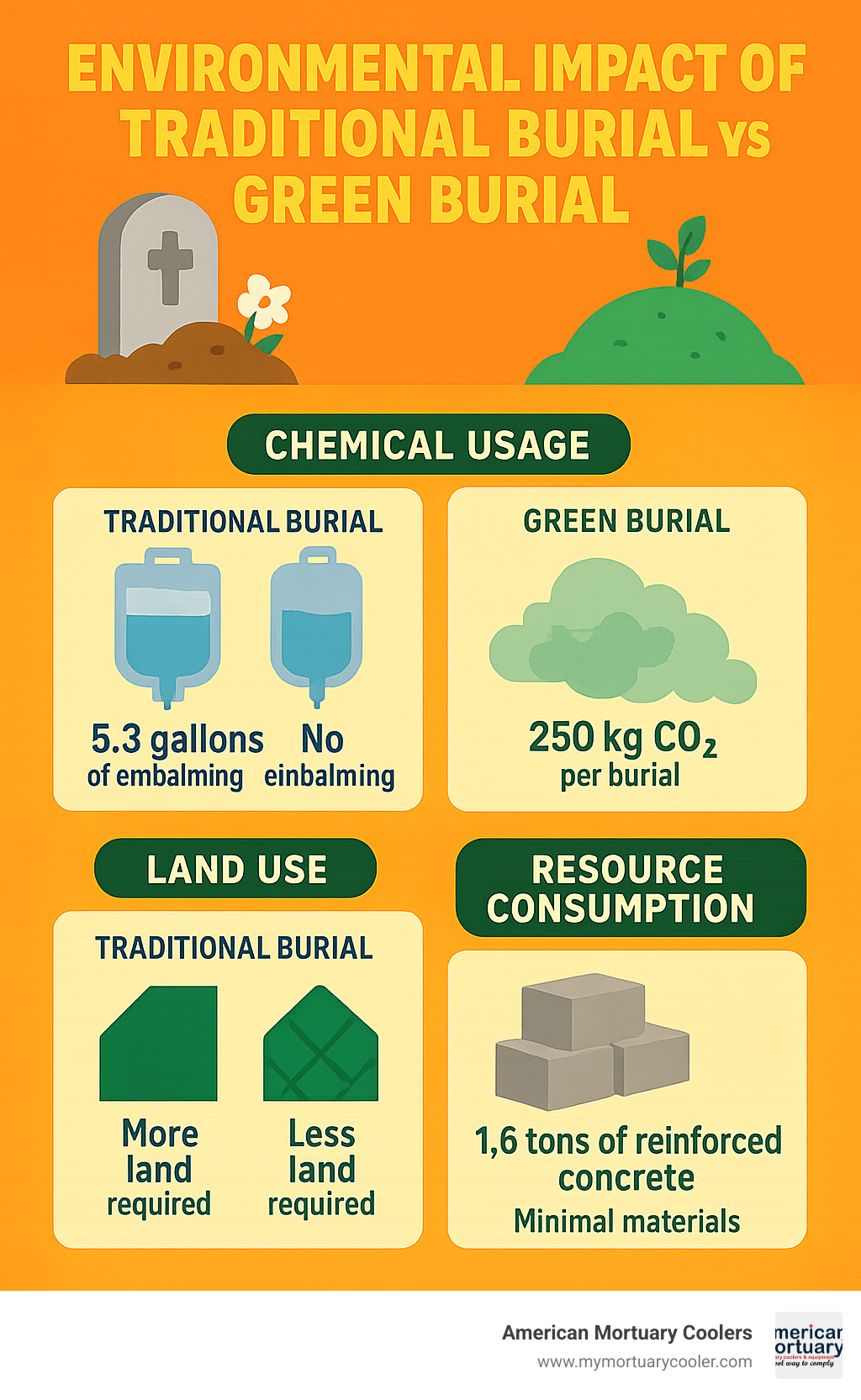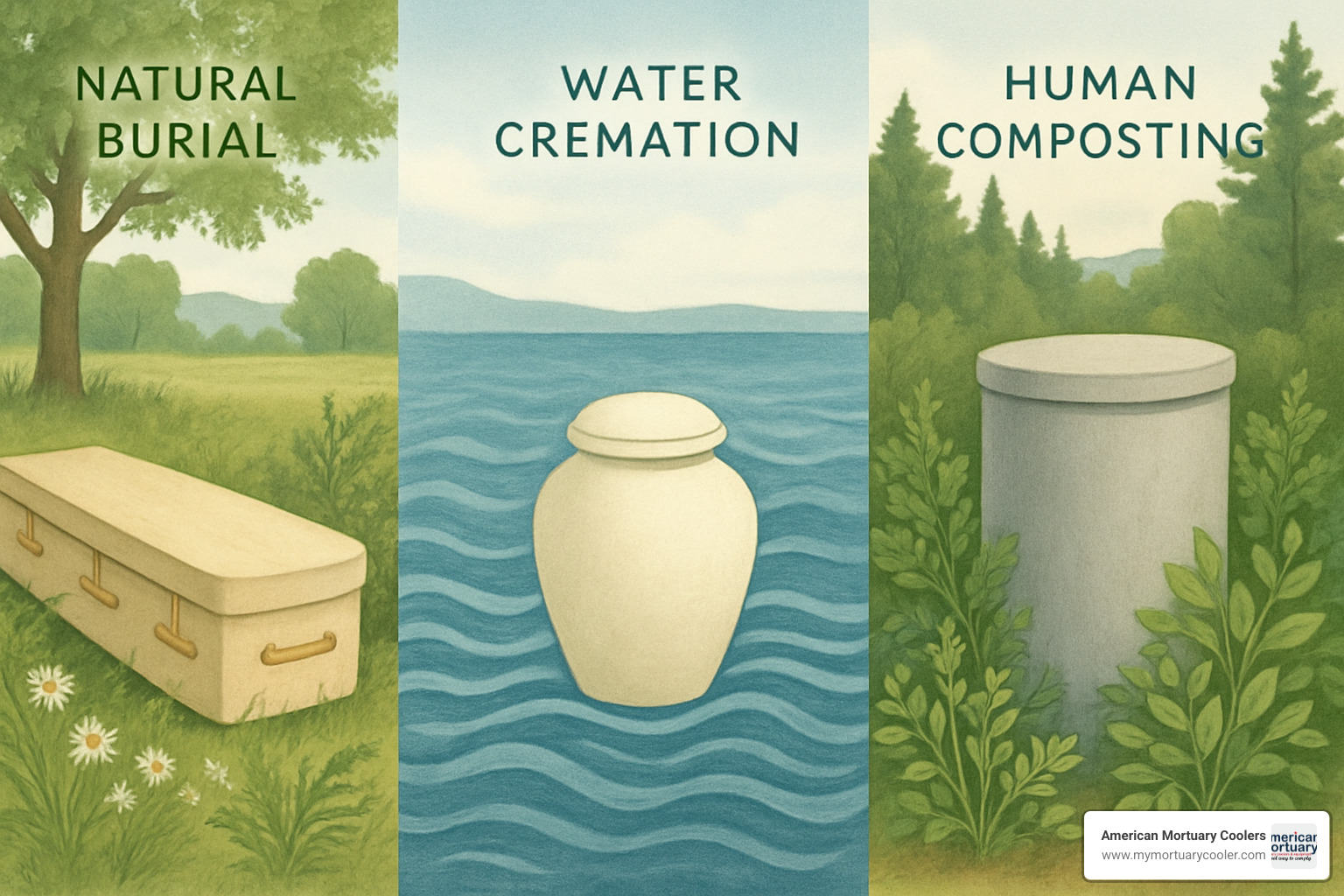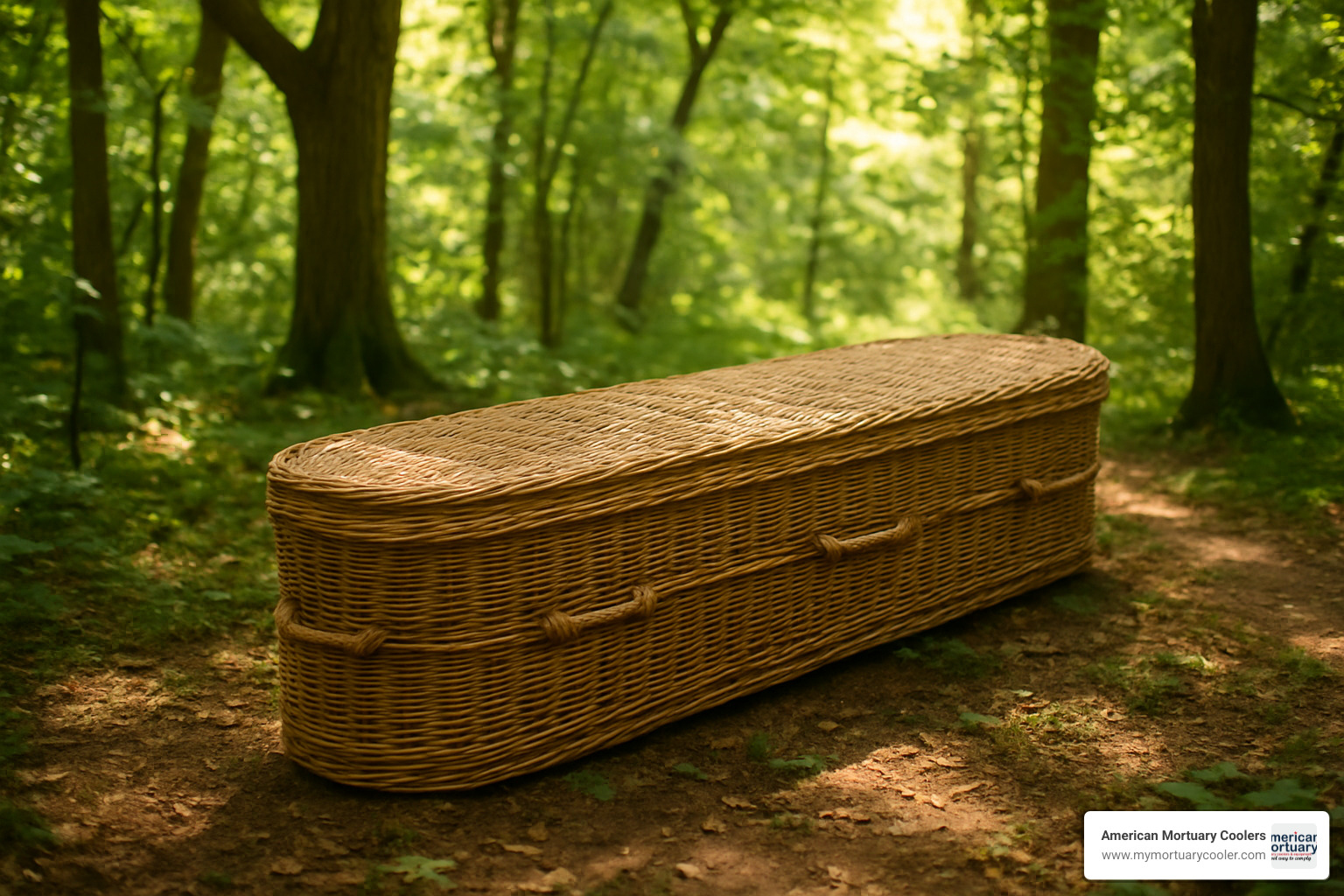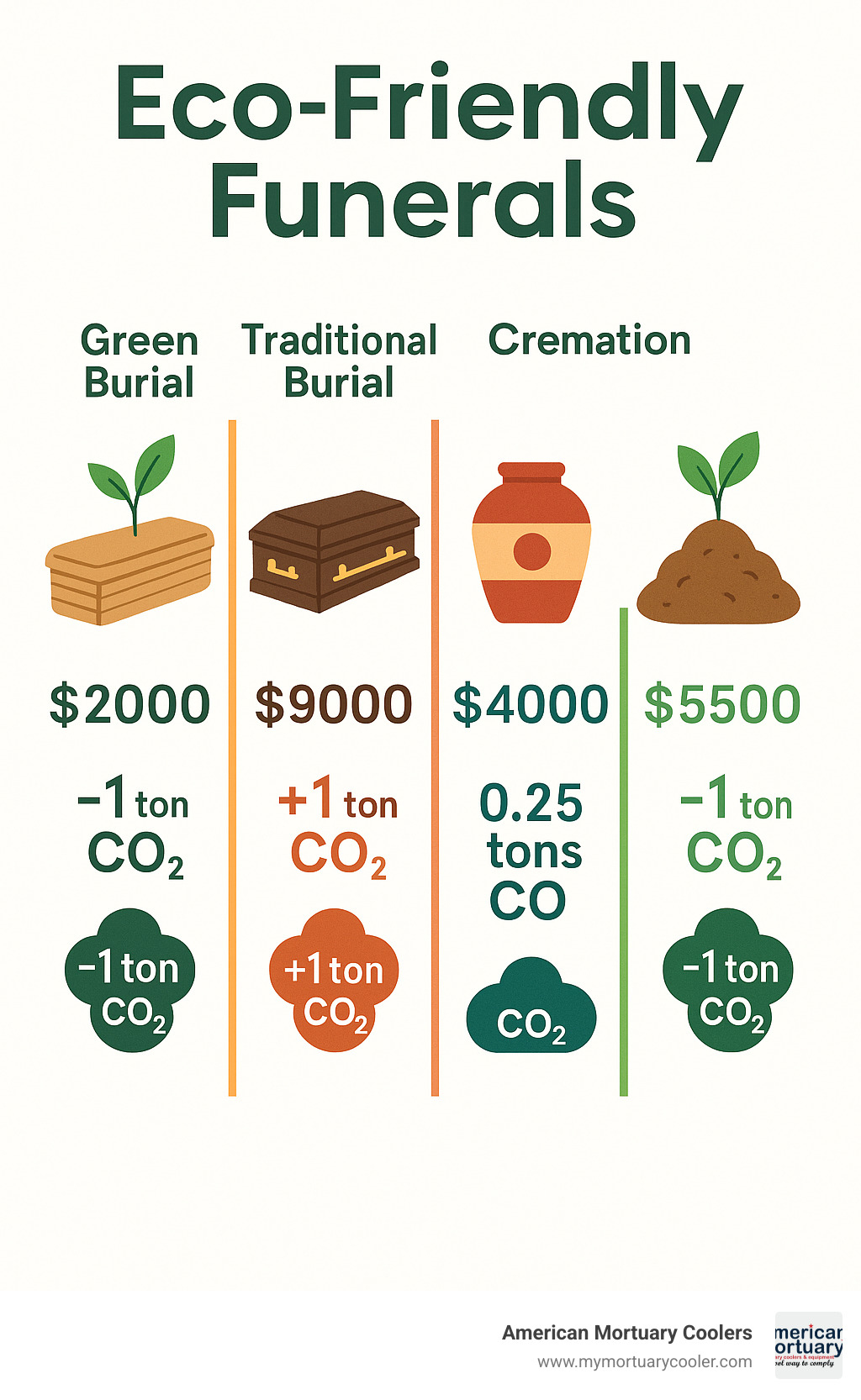
Everything You Need to Know About Eco-Friendly Funerals
Why Eco-Friendly Funerals Are Changing Death Care
Eco friendly funerals are sustainable alternatives to traditional burial and cremation that minimize environmental impact through natural decomposition, biodegradable materials, and conservation-focused practices. These green options are growing rapidly as families seek meaningful ways to honor loved ones while protecting the planet.
Key Types of Eco-Friendly Funerals:
- Green Burial - No embalming, biodegradable caskets/shrouds, natural burial grounds
- Water Cremation (Aquamation) - Uses 90% less energy than flame cremation
- Human Composting - Transforms remains into nutrient-rich soil
- Conservation Burial - Protects land through permanent conservation easements
Main Benefits:
- Saves 1+ metric tons of carbon per person vs. traditional burial/cremation
- Costs $2,000-$3,000 vs. $8,000-$10,000 for conventional funerals
- Preserves natural habitats and supports biodiversity
- Eliminates toxic chemicals from soil and groundwater
When Jon Hallford leaned over a casket to kiss a relative farewell, he was affronted by the smell of embalming fluid - an experience that inspired him to open Colorado's first green funeral home. His story reflects a growing movement as funeral directors nationwide recognize the demand for sustainable death care options.
The numbers tell a compelling story. In British Columbia, 87% of consumers choose cremation - often for cost savings. But even cremation produces 535 pounds of CO₂ per service. Meanwhile, conventional U.S. burials consume 30 million board feet of hardwood annually and bury 2 billion kilograms of reinforced concrete each year.
I'm Mortuary Cooler, a national-level mortuary equipment supplier who has worked extensively with funeral homes transitioning to more sustainable practices, including those offering eco friendly funerals. Through years of supporting directors seeking energy-efficient, durable equipment, I've witnessed how the industry is evolving to meet growing environmental concerns while maintaining the dignity families deserve.

Quick look at eco friendly funerals:
Environmental Cost of Conventional Burial & Cremation
Most families don't realize the hidden environmental costs lurking behind traditional funeral practices. Conventional funerals fight against nature itself - and the environmental price tag is enormous.
Traditional burials flood our soil with toxic chemicals through the embalming process. Every body requires at least 12 liters of formaldehyde-based solution to preserve it for viewing. These chemicals don't disappear after burial - they seep into groundwater, contaminate local water supplies, and affect soil health for decades.
The casket industry devours natural resources at an alarming rate. Those beautiful hardwood caskets come from forests that took decades to grow. Metal caskets require energy-intensive mining and manufacturing processes. Then we wrap it all in concrete vaults that create permanent barriers against natural decomposition.
Cremation might seem like the greener choice, but it comes with its own baggage. Those massive furnaces burn fossil fuels at 1,400-1,800°F for hours, pumping CO₂ directly into the atmosphere. The energy requirements are substantial - imagine running your entire home's heating system at maximum power for several hours straight.
This is where eco friendly funerals offer such a compelling alternative. Instead of fighting against natural processes, they work with them.
Statistics That Matter
The numbers behind conventional funeral practices are jaw-dropping:
Wood consumption hits 30 million board feet annually in the U.S. alone - equivalent to clear-cutting 3.6 million hectares of forest every year just for caskets. Meanwhile, each cremation produces 535 pounds of CO₂, the same emissions as driving from Vancouver to Calgary.
Chemical contamination adds up fast. American cemeteries receive 3 million liters of embalming fluid every year - enough toxic chemicals to fill an Olympic-sized swimming pool.
Metal and concrete usage reaches industrial scales. We bury 2 billion kilograms of reinforced concrete annually in vaults, plus nearly 3 million kilograms of copper and bronze and 104 million kilograms of steel in caskets. That concrete alone could build thousands of kilometers of highway - instead, it sits underground preventing natural decomposition.
These figures represent just one country's impact. When funeral directors tell me they're exploring sustainable options, I understand why. The traditional approach treats death like an industrial process rather than a natural transition.
Eco Friendly Funerals: Core Principles & Emerging Options

Eco friendly funerals are built on a simple idea: working with nature instead of fighting against it. These sustainable options share core values - minimize harmful chemicals, reduce carbon emissions, conserve resources, and help ecosystems thrive.
The choices available today range from time-tested green burial practices to cutting-edge human composting technology. There's also alkaline hydrolysis (water cremation), promession (freeze-drying), and innovative tree-pod burials. Many families are also choosing conservation cemeteries that protect land forever while providing peaceful resting places.
From my experience working with funeral homes across the country, I've seen how these options often require different equipment and procedures. We've had increased requests for energy-efficient refrigeration systems that can preserve bodies naturally without chemical intervention.
More info about eco-options breaks down each method's specific environmental benefits and practical considerations.
Green Burial Standards
Green burial brings us back to how humans honored their dead for thousands of years - with simplicity and respect for natural processes. The Green Burial Council has established clear standards that make this ancient practice work in our modern world.
No embalming forms the foundation of green burial. Bodies decompose naturally without introducing toxic formaldehyde into soil and groundwater. This means funeral homes need reliable refrigeration to maintain bodies during planning periods.
Biodegradable shrouds and caskets replace traditional metal caskets and concrete vaults. Families can choose beautiful shrouds made from cotton, linen, hemp, or wool. Caskets crafted from willow, bamboo, pine, or recycled cardboard allow complete decomposition while providing dignity and beauty for services.
Hand-dug graves minimize machinery use and carbon emissions while creating proper depth of 3.5 to 4 feet. This ensures healthy decomposition while maintaining adequate soil barriers. Many sites use GPS coordinates instead of permanent stone markers.
Native habitat restoration turns burial grounds into thriving ecosystems. Instead of manicured lawns requiring constant water and chemicals, these sites support local wildlife and plant communities. Some conservation cemeteries protect thousands of acres through permanent easements.
The Green Burial Council certifies three levels: hybrid sections within traditional cemeteries, natural burial grounds that operate entirely without vaults or chemicals, and conservation burial grounds that combine interment with permanent land protection.
Scientific research on natural burial shows these sites can become biodiversity hotspots that support far more life than traditional cemeteries.
Water Cremation (Aquamation)
Water cremation offers a gentler alternative to flame cremation that many families find deeply appealing. Also called alkaline hydrolysis or aquamation, this flameless process uses heated water and potassium hydroxide to accelerate what naturally happens in soil over many years.
The environmental benefits are impressive. Research shows water cremation uses only 10% of the energy required for flame cremation. The process produces no air emissions and creates approximately 270 gallons of sterile water. That water is completely safe for standard wastewater treatment.
The body is placed in a sealed chamber with heated alkaline solution. Over several hours, soft tissues dissolve completely, leaving only bones that are processed into fine powder similar to traditional cremation ashes. Families receive about 20% more remains than with flame cremation.
Legal status varies by location, with 20 U.S. states and several Canadian provinces currently allowing the process. The technology continues expanding as more jurisdictions recognize its environmental benefits.
More info about water cremation explains the technical details and current legal status across different regions.
Human Composting & Natural Organic Reduction
Human composting represents the newest frontier in sustainable death care - changing human remains into rich, life-giving soil through natural organic reduction.
The process begins by placing the body in a sealed container with organic materials like wood chips, straw, and alfalfa. Over 30 to 50 days, naturally occurring microbes break down all organic matter, including bones. The container is rotated and aerated periodically to create optimal conditions.
The carbon savings are remarkable - human composting can save just over one metric ton of carbon per person compared to traditional burial or cremation. The process uses minimal energy, mainly for rotation systems.
Legalization trends show growing acceptance. New York became the sixth state to legalize human composting in 2022, joining Washington, Colorado, Oregon, Vermont, and California. More states are considering similar legislation.
The resulting soil can nourish gardens, restore forests, or support conservation projects. Each body produces approximately one cubic yard of rich soil.
More info about human composting provides comprehensive details about the process, costs, and legal considerations.
Planning & Personalizing an Eco-Friendly Funeral

Planning an eco friendly funeral opens doors to deeply personal experiences that traditional services often can't provide. Unlike conventional funerals where families typically hand everything over to professionals, green options invite meaningful participation that can help with the grieving process.
Take home funerals, for instance. Many families don't realize they can care for their loved one at home using simple refrigeration or dry ice. This practice was completely normal until the 1930s and remains legal in most places.
The beauty of eco friendly funerals lies in their flexibility for personalization. Families can weave together traditions that feel right - maybe creating biodegradable urns from handmade pottery, choosing wildflower meadow burial sites, or organizing walking processions that honor both the person and the planet.
Digital elements add another layer of personalization while reducing environmental impact. Digital obituaries reach far more people than newspaper notices, and online memorial websites can include photos, videos, and stories. Some families create QR codes for headstones that link to these digital memorials.
Transportation choices make a bigger difference than most people think. I've seen families organize beautiful bicycle processions, shared carpools to reduce emissions, or choose venues accessible by public transit.
Living memorials create lasting tributes that keep giving back. Families plant native trees, establish pollinator gardens, fund conservation projects, or create habitat restoration sites. Instead of cut flowers that wilt, guests might receive seed packets to plant in their own gardens.
Budget & Affordability of Eco Friendly Funerals
Here's something that surprises many families: eco friendly funerals typically cost far less than traditional services. We're talking about $2,000-$3,000 for green burial compared to $8,000-$10,000 for conventional funerals.
The savings come from eliminating expensive components that don't actually serve families' needs. No embalming costs (usually $500-$800), no metal caskets ($2,000-$10,000), no concrete vaults ($1,000-$3,000). Green burial grounds often charge lower fees too.

Water cremation usually falls between traditional cremation and green burial costs, while human composting runs about $4,000-$7,000 where it's available. Still significantly less than traditional burial, plus you get that metric ton of carbon savings.
DIY elements can stretch budgets even further. Families often build simple pine or cardboard caskets, sew cotton or linen shrouds, or arrange flowers from their own gardens. Many green burial grounds welcome family participation in grave digging - which often becomes a powerful healing ritual.
For families wanting to go completely carbon-neutral, carbon offset programs cost just $20-$100.
Legal, Cultural & Religious Considerations
The legal side of eco friendly funerals is simpler than most people expect, though it varies by location. Green burial is legal everywhere, but each state or province has its own requirements about burial depths, permit requirements, and whether families can handle arrangements themselves.
The Green Burial Council helps steer these waters with their three certification levels. Hybrid cemeteries offer green sections within traditional grounds. Natural burial grounds operate entirely without vaults or chemicals. Conservation burial grounds add permanent land protection.
Most faiths actually support natural burial as a return to historical practices. Jewish and Islamic traditions have always preferred rapid, simple burial. Many Christian denominations see green burial as good stewardship of creation. Indigenous practices often align perfectly with natural burial principles.
The paperwork requirements mirror traditional funerals - you still need death certificates, burial permits, and health department approvals. The main difference is eliminating vault requirements in certified green cemeteries.
Cultural acceptance continues growing as people learn about the options. What seemed unusual just a decade ago now feels natural to many families seeking authentic ways to honor their loved ones while protecting the environment.
How to Choose Providers & Advocate for Change
When you're ready to plan an eco friendly funeral, finding the right providers can feel overwhelming. The good news is that more funeral homes and cemeteries are embracing green practices as families demand sustainable options.
Start by asking funeral directors about their experience with green burials. Do they offer biodegradable caskets and shrouds? Can they maintain bodies through refrigeration instead of embalming? What relationships do they have with certified green cemeteries? These questions quickly reveal whether a funeral home truly supports eco-friendly practices.
Cemetery policies matter just as much. Some green burial grounds welcome family participation in grave digging, while others require professional oversight. Certain sites restrict memorial options to flat stones or GPS coordinates, while others allow small plantings or natural markers.
The funeral industry is evolving rapidly. At American Mortuary Coolers, we've worked with directors across Tennessee, California, and throughout our 48-state service area who are investing in energy-efficient refrigeration systems to support green burial practices.
More info about choosing green funeral homes provides detailed guidance on evaluating providers and asking the right questions during this important selection process.
Finding Local Eco Friendly Funerals Services
The availability of eco friendly funeral services varies dramatically depending on where you live. Urban areas typically offer more choices, while rural communities might have fewer options but potentially more flexibility for creative approaches.
Canada has been a leader in green burial development. Woodlands at Royal Oak Burial Park in Victoria offers green burial sections within their traditional cemetery grounds. Nature Grove Green Burial Garden in Parksville specializes in natural interment options, while Salt Spring Island Natural Cemetery focuses exclusively on eco-conscious burials. Denman Island Natural Burial Cemetery maintains one of the country's most dedicated natural burial grounds.
Canada's first urban green burial site opened in Victoria, BC in 2008, and more than 10 certified sites have opened since then. This growth reflects both increasing demand and regulatory acceptance of sustainable death care practices.
In the United States, the Green Burial Council maintains comprehensive directories of certified providers. Their website allows you to search by location and certification level, making it easier to find appropriate options in your area.
Provider directories from the National Home Funeral Alliance and Funeral Consumers Alliance offer additional resources for finding green burial options and guidance for families considering home funerals.
Advocating for Eco Friendly Funerals in Your Area
If your community lacks green burial options, don't despair. Many areas simply haven't developed these services because local demand hasn't been clearly demonstrated to cemetery operators and funeral directors.
Public education campaigns can be surprisingly effective. Community presentations at libraries, environmental group partnerships, and workshops help spread awareness about the environmental impacts of traditional funerals and the benefits of sustainable alternatives. When people understand that conventional burials use 3 million liters of embalming fluid annually and that green burials can save over one metric ton of carbon per person, they often become enthusiastic advocates.
Petitioning local cemeteries to add green burial sections frequently succeeds once operators understand the demand. Many cemetery boards are willing to designate areas for green burial when they see community interest and understand the regulations.
Sustainable land trusts offer another creative avenue for establishing green burial grounds. Environmental organizations sometimes partner with communities to create conservation burial grounds that protect valuable land while providing meaningful burial options.
Policy reform becomes necessary when advocating for newer options like human composting or water cremation. Contacting legislators about environmental benefits and constituent demand can influence regulatory changes.
Frequently Asked Questions about Eco Friendly Funerals
When families first learn about eco friendly funerals, they naturally have questions about legality, costs, and practical concerns. Having worked with funeral homes across the country as they transition to greener practices, I've heard these same questions countless times.
Are eco friendly funerals legal everywhere?
The short answer is that basic eco friendly funerals are legal throughout North America, but the details vary depending on where you live.
Green burial is completely legal in all U.S. states and Canadian provinces. The main differences involve burial depth requirements - some places require just 18 inches of soil cover, while others mandate 3-4 feet. Container rules also vary, with some jurisdictions allowing simple shrouds while others require biodegradable caskets.
Water cremation (alkaline hydrolysis) is currently legal in 20 U.S. states and several Canadian provinces. More jurisdictions consider approval each year as the technology proves itself safe and effective.
Human composting represents the newest option, currently legal in six U.S. states: Washington, Colorado, Oregon, Vermont, California, and New York. Additional states are reviewing legislation as public interest grows.
Home funerals face the most variation in regulations. Seven states require licensed funeral director involvement: Connecticut, Indiana, Louisiana, Michigan, Nebraska, New York, and Utah. Most other places allow families to care for their loved ones at home with proper permits.
The regulatory landscape continues evolving as more families choose sustainable options.
Do eco friendly funerals really save money?
Absolutely - and the savings can be substantial. Eco friendly funerals typically cost $2,000-$3,000 compared to $8,000-$10,000 for traditional burials.
The savings come from eliminating expensive components that don't serve the deceased or grieving families. No embalming saves $500-$1,500. Choosing biodegradable containers instead of metal caskets saves $2,000-$8,000. Skipping concrete vaults saves another $1,000-$3,000. Many green cemeteries also charge lower fees since they don't maintain elaborate landscaping.
Hidden fees are actually fewer with green options because the process is simpler. Traditional funerals often include charges for embalming, casket rental for viewings, vault installation, and various service fees that simply don't apply to natural burial.
Families can reduce costs further through DIY elements like building simple caskets, creating shrouds, or arranging flowers from their gardens. Just balance potential savings against your emotional needs and practical capabilities during a difficult time.
Will wildlife disturb a natural grave?
This concern comes up frequently, and I understand why families worry about it. The good news is that properly conducted green burials pose minimal risk of wildlife disturbance. Decades of experience and research back this up.
The key is proper burial depth - that recommended 3.5-4 feet isn't arbitrary. Even aggressive diggers like wild boar typically only excavate to about 12 inches. The 18-24 inch "smell barrier" of soil above remains prevents detection by most animals.
Human remains simply aren't attractive to most wildlife when properly buried. The natural decomposition process doesn't create the scents that typically attract scavenging animals.
Water table safety stays protected through required setbacks from surface water. Burial sites at 3-4 feet depth stay well separated from potable water sources. Soil naturally filters and processes organic matter, preventing contamination.
Green burial grounds across North America have operated for decades without significant wildlife issues. Proper techniques and site selection make the difference.
Conclusion
The journey toward eco friendly funerals represents something profound - a chance to honor our loved ones while nurturing the planet that gave them life. Throughout this guide, we've explored how these sustainable options create a beautiful circle where death becomes part of life's renewal rather than an environmental burden.
The numbers tell an inspiring story. When families choose green burial, they're preventing over a metric ton of carbon emissions, keeping toxic chemicals out of soil and groundwater, and often saving thousands of dollars. But beyond the statistics lies something deeper - the opportunity to create meaningful, personal farewells that reflect our values and care for future generations.
Whether your family is drawn to the gentle simplicity of green burial, the innovative science behind water cremation, or the transformative promise of human composting, each option offers its own path to sustainable death care. These aren't just alternatives to traditional funerals - they're often more personal, more affordable, and more aligned with how many of us want to live and be remembered.
At American Mortuary Coolers, we've witnessed this change firsthand. From our Tennessee headquarters, we've watched funeral directors across all 48 contiguous states accept sustainable practices. Our energy-efficient mortuary coolers and custom equipment help these professionals offer families the dignity they deserve while supporting natural body preservation methods that make green burial possible.
The movement toward eco friendly funerals is growing stronger every year. More states are approving human composting, more cemeteries are adding green sections, and more families are finding that sustainable death care often feels more meaningful than traditional options. This isn't just a trend - it's a return to practices that honor both our loved ones and the earth that sustains us all.
If you're exploring these options for yourself or a family member, choosing sustainable death care is ultimately an act of love. It's a way to ensure that your final chapter contributes to the health and beauty of the world you're leaving behind.
More info about funeral supplies & equipment for funeral directors ready to support families in their journey toward sustainable death care.



